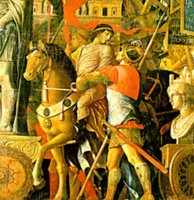Beware the Ides of March!
 Got Caesar?
Got Caesar?Some despise Caesar for his ambition, while others praise him for his devotion to Rome. No matter what we think of Caesar, he looms large in our imaginations. Was he "the nobles man / That evr lived in the tide of times" as Marc Antony describes him in Shakespeare's Julius Caesar? Or was he an ambitious tyrant on the verge of destroying the Roman Republic as Brutus believed? Did he wear a white toga or a black toga?
One of the more interesting ways to understand the historical figure of Julius Caesar is to look at how he has been representing in the popular media - from Shakespeare to HBO.
Written probably in 1599, Shakespeare's play, Julius Caesar, is fundamental to many people's knowledge of Caesar. Shakespeare based his depiction on a biography written by the ancient historian Plutarch. In funeral speeches given by Brutus and Marc Antony, Shakespeare contrasts the image of Caesar as tyrant with the image of Caesar as the noble savior of his country.
Twelve films about the life of Caesar have been made since 1914. One of the most successful brings Shakespeare's play to the silver screen - it was directed by Joseph Mankiewicz in 1953 and it stays quite close to the Shakespearean text. It stars James Mason as Brutus, Louis Calhern as Caesar, and the young Marlon Brando as Antony. All provide powerful performances.
Since 1938, there have been eleven television productions that illustrate the life of Julius Caesar. Certainly the most ambitious and the most scenographic is HBO's ROME, which premiered in fall of 2005.
Filmed at Cinecitta Studios in Rome, where an enormous set of the Roman Forum was created, the series depicts the final year of Caesar's life. The show's makers take a cue from Shakespeare as they illustrate the duality of Caesar's character, presenting him as noble one moment and despicable the next.
Though these media accounts are "fictional," they are also powerful. They give shape to our images of ancient Rome and its most provocative ruler. And, importantly, such mulitmedia representations of Julius Caesar's life provoke us to marvel at the complexities of political power in ancient Rome and to compare it to our own complicated world.




